- Author Rachel Wainwright [email protected].
- Public 2023-12-15 07:39.
- Last modified 2025-11-02 20:14.
Barotrauma
The content of the article:
- Causes and risk factors
-
Symptoms
- Barotrauma of the lungs
- Ear barotrauma
- Paranasal sinus barotrauma
- Barotrauma of teeth
- Barotrauma of soft tissues under a diving mask
- Barotrauma of the eye
- Barotrauma of the gastrointestinal tract
- Diagnostics
- Treatment
- Possible complications and consequences
- Forecast
- Prevention
Barotrauma - damage to the tissues of body cavities (ears, lungs, paranasal sinuses, air cavities in the teeth, hollow organs of the gastrointestinal tract) by a sudden change in the volume of air contained in them under the influence of changes in external pressure.
Causes and risk factors
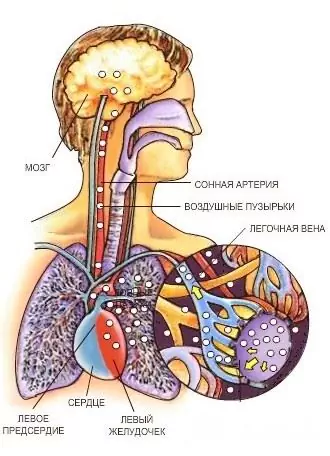
Normally, the air pressure inside the hollow organs corresponds to the external pressure. Its sharp drop leads to the fact that the difference between the air pressure in the cavities and the external pressure increases rapidly, and this negatively affects the state of the tissues. For example, a sharp drop in atmospheric pressure causes an increase in air pressure in the middle ear and bulging of the eardrum. Conversely, an increase in external pressure leads to a decrease in the pressure in the middle ear cavity and retraction of the tympanic membrane.
The reasons for the development of barotrauma can be:
- fast immersion in water when diving or, on the contrary, too fast ascent from depth to the surface;
- depressurization of the aircraft cabin at high altitude;
- shock wave resulting from a nearby explosion;
- non-observance of safety measures during a number of medical procedures (with pneumatic massage of the tympanic membrane, treatment in a pressure chamber).
Barotrauma is more often observed in patients with diseases of the oropharynx, nose, and lungs. This is due to the fact that inflammation of the mucous membrane of these organs is accompanied by edema, which makes it difficult to equalize the pressure in the cavities when the atmospheric pressure changes.
Symptoms
The first symptoms of barotrauma appear immediately after a sharp and significant change in pressure. The clinical picture of the disease is determined by the location of the damage.
Barotrauma of the lungs
When immersed in water with prolonged breath holding, the lungs are compressed. In some cases, this leads to a decrease in lung volume, edema of the mucous membranes, stagnation in the microvasculature, and bleeding. When rising to the surface, the described changes in the lung tissue are clinically manifested by hemoptysis and respiratory failure.
When diving with scuba diving, breathing is carried out with compressed air. With insufficient exhalation or too fast ascent to the surface, the air contained in the alveoli expands sharply, causing overstretching of the walls of the alveoli and their rupture. Alveolar rupture leads to the development of pneumothorax or pneumomediastinum. Signs of pneumothorax:
- dyspnea;
- chest pain;
- unilateral attenuation of respiratory sounds.
The most severe is a tense pneumothorax, which, in addition to the described symptoms, is characterized by:
- swelling of the neck veins;
- arterial hypotension;
- deviation of the trachea to the side;
- boxed percussion sound over the affected lung.
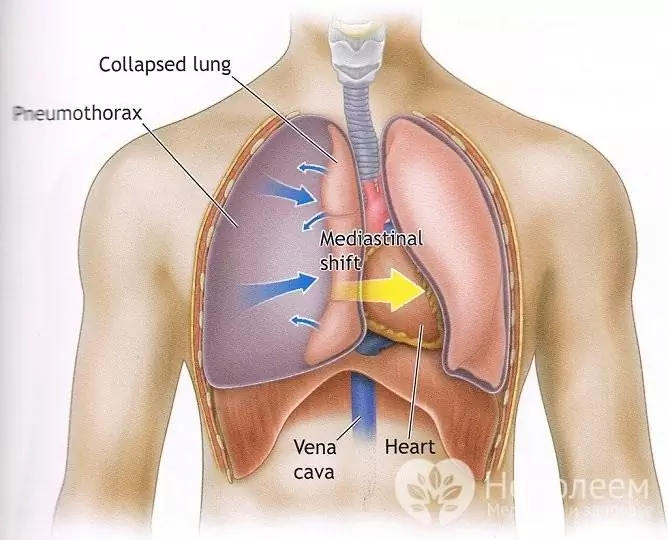
Tension pneumothorax with barotrauma
The development of pneumomediastinum is accompanied by:
- pain in the chest and neck;
- a feeling of fullness in the chest;
- breathing disorder;
- dysphagia;
- dysphonia;
- subcutaneous emphysema in the neck;
- characteristic crackling sounds during auscultation of the heart at the time of systole (Hammen's symptom).
Ear barotrauma
Barotrauma of the outer, middle and inner ear occurs most often. Their first symptoms are pain and a feeling of stuffiness in the ears. If the pressure inside the ear cavities does not quickly equalize, rupture of the eardrum, bleeding from the middle ear, and hearing loss can occur. With otoscopy, insufficient mobility of the tympanic membrane, hemotympanum is noted.
Inner ear barotrauma is the most severe. With them, a rupture of an oval or round window occurs, as a result of which:
- dizziness;
- noise in ears;
- nausea, vomiting;
- sensorineural hearing loss.

Ear barotrauma may be accompanied by rupture of the tympanic membrane
Paranasal sinus barotrauma
The first symptom of damage to the paranasal sinuses in barotrauma is the appearance in them of unpleasant sensations of varying severity (from a moderate feeling of pressure to severe pain). There may be nosebleeds. When the paranasal sinus ruptures, the air contained in it penetrates into the cranial cavity, leading to the development of pneumocephalus. In this case, the victims complain of severe pain in the face and oral cavity, unbearable headache, excruciating nausea, and repeated vomiting.
Barotrauma of teeth
When the external pressure changes, the volume of air bubbles in the roots of teeth affected by caries changes. This becomes the cause of pain, with severe barotrauma, even complete destruction of the tooth is possible.
Barotrauma of soft tissues under a diving mask
During the descent under the water, it is necessary to systematically equalize the pressure in the mask space. If this is not done, a relative vacuum forms between the face and the mask, which leads to subcutaneous hemorrhages of the face and hemorrhages of the conjunctiva.
Barotrauma of the eye
Barotrauma of the eyes occurs only when rigid gas-permeable contact lenses are used for vision correction. Small air bubbles are always present between them and the cornea. When the pressure changes, their volume changes, as a result of which pressure is exerted on the cornea. Clinically, this is manifested by the following symptoms:
- Pain in the eyes;
- the appearance of a halo when looking at a bright light source;
- significant decrease in visual acuity.
Barotrauma of the gastrointestinal tract
When diving under water, if the breathing technique is incorrect, the diver may swallow small volumes of air. During a rapid ascent, this air increases sharply in volume, causing:
- feeling of fullness in the abdominal cavity;
- abdominal pain;
- flatulence;
- belching;
- intestinal cramps.
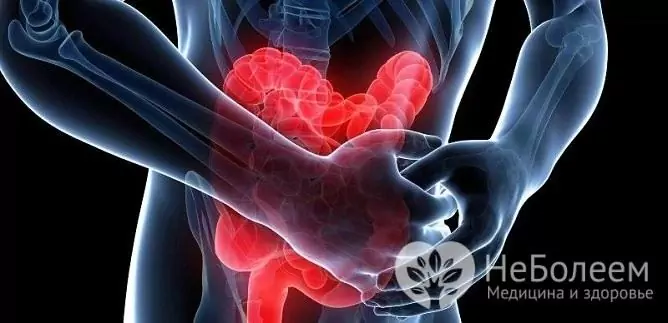
If barotrauma is accompanied by rupture of the stomach or intestines, there is a clinical picture of an acute abdomen
As a rule, the described symptoms quickly disappear after rising to the surface, without requiring treatment. However, in rare cases, severe barotrauma of the stomach or intestines, accompanied by rupture of the organ, is possible. In such a case, a clinical picture of an acute abdomen develops, which is characterized by:
- high intensity abdominal pain;
- strong tension of the abdominal muscles ("board-like" belly);
- a positive symptom of Shchetkin - Blumberg, indicating irritation of the peritoneum (if you gently press on the stomach and then quickly withdraw your hand, the pain will increase dramatically).
Diagnostics
Diagnosis of barotrauma begins with examining the patient and collecting anamnesis, during which the cause of barotrauma is established. Depending on which organ is affected, further diagnostics will have features.
With barotrauma of the lungs and suspected rupture of the alveoli, an X-ray examination of the chest is performed in a standing position. In the presence of pneumothorax or pneumomediastinum, a clearly visible contrast strip appears along the contour of the heart. In difficult diagnostic cases, they resort to computed tomography of the chest organs: this method is more sensitive than standard radiography.

Lung barotrauma on x-ray
With barotrauma of the ear, otoscopy and audiometry are performed. If necessary, the vestibular apparatus is tested, as well as the study of the neurological status.
Diagnosis of barotrauma of the paranasal sinuses is carried out on the basis of the characteristic clinical picture of the lesion. The performance of imaging diagnostic techniques is not shown. However, if there is a suspicion of sinus rupture and the formation of pneumocephalus, a CT scan of the head is performed.
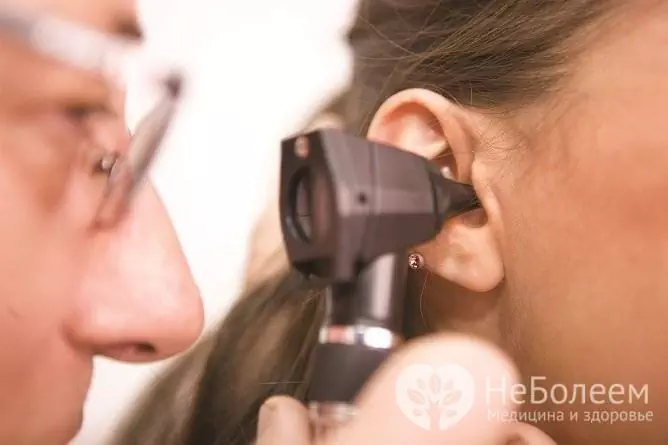
For barotrauma of the ear, otoscopy and audiometry are indicated
Barotrauma of teeth, eyes and soft tissues under the mask is diagnosed according to the characteristic clinical signs. If necessary, an examination by a dentist or ophthalmologist is carried out.
With barotrauma of the gastrointestinal tract, X-ray or computed tomography of the abdominal organs is performed. A surgeon's examination is required.
Treatment
With mild barotrauma, outpatient medical supervision of the patient is established, if necessary, symptomatic therapy is prescribed.
Barotrauma of the lungs and organs of the gastrointestinal tract, accompanied by the appearance of peritoneal symptoms, signs of pneumothorax, symptoms of neurological disorders, impaired hemodynamic stability and respiratory disorders, are considered as potentially life-threatening. In this case, the patients are subject to urgent hospitalization.
If the lungs are damaged, patients are allowed to inhale 100% humidified oxygen. With an increase in the phenomena of respiratory failure, the trachea is intubated and the patient is transferred to apparatus breathing. With the manifestations of pronounced or growing pneumothorax, puncture of the pleural cavity is performed along the midclavicular line in the second intercostal space with a thick trocar.
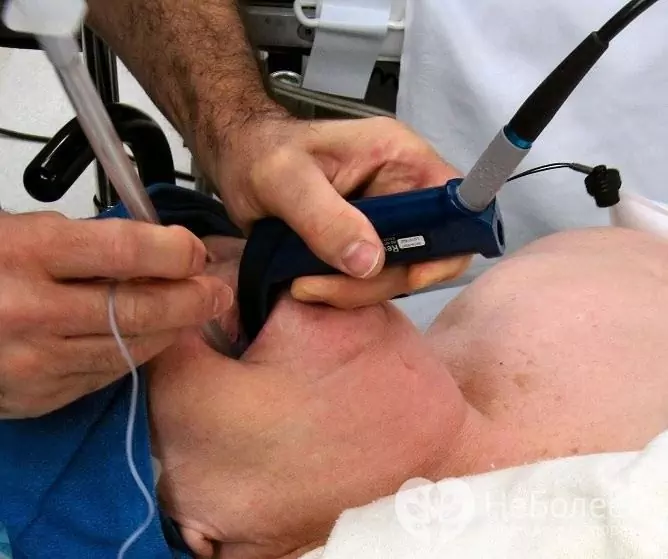
If barotrauma leads to respiratory failure, tracheal intubation is performed
In pneumomediastinum, the victim is allowed to inhale 100% humidified oxygen supplied by a large flow. In rare cases, it becomes necessary to perform a mediastinotomy.
If barotrauma has caused a rupture of the stomach or intestines, an emergency surgical intervention is needed to close the defect and fight peritonitis. In the postoperative period, massive infusion therapy is carried out, broad-spectrum antibiotics are prescribed.
Therapy for barotrauma of the paranasal sinuses and ear includes:
- intranasally - vasoconstrictor agents (to reduce soft tissue swelling);
- intranasally - glucocorticoids (which have a powerful anti-inflammatory and anti-edema effect);
- injection - non-steroidal anti-inflammatory drugs (to relieve pain).
If there is a sign of sinus effusion or bleeding, a course of antibiotic therapy must be carried out for at least 10 days.
Serious damage to the structures of the inner ear and sinus rupture require surgical treatment.
The development of neurological symptoms in a patient who has experienced barotrauma indicates a gas embolism of the cerebral vessels. In this case, the main method of treatment is placing the patient in a decompression chamber.

A decompression chamber is indicated if the patient has signs of cerebral embolism
Possible complications and consequences
The most dangerous barotrauma is damage to the lungs and organs of the digestive tract. With barotrauma of the lungs, accompanied by rupture of the alveoli, air can enter the vasculature, which leads to a gas embolism in the brain. As a result, severe hypoxia and ischemia of the brain tissue develop, which can have serious neurological consequences and even end in death.
Barotrauma of the digestive system sometimes leads to a violation of the integrity of the hollow organs (with the development of diffuse peritonitis).
Barotrauma of the inner ear can cause the formation of a labyrinth fistula with the expiration of perilymph.
Forecast
The prognosis for barotrauma in most cases is favorable. With the addition of complications, it worsens significantly.
Prevention
To prevent barotrauma, you need to adhere to the following rules:
- when flying by air during an airplane's climb and descent, it is recommended to chew gum or suck on lozenges (the swallowing movements performed while improving the patency of the Eustachian tube);
- when riding extreme attractions (for example, on a roller coaster), it is better to keep your mouth slightly open (which helps to quickly restore the pressure balance);
- when diving, you must carefully follow the safety requirements.
Timely treatment of diseases of the upper respiratory tract (otitis media, rhinitis, sinusitis, pharyngitis) is of great importance in the prevention of barotrauma. In the presence of these diseases, it is necessary to avoid situations in which there is a risk of barotrauma (it is not recommended to ride high-speed or high-altitude attractions, diving, etc.).

Elena Minkina Doctor anesthesiologist-resuscitator About the author
Education: graduated from the Tashkent State Medical Institute, specializing in general medicine in 1991. Repeatedly passed refresher courses.
Work experience: anesthesiologist-resuscitator of the city maternity complex, resuscitator of the hemodialysis department.
The information is generalized and provided for informational purposes only. At the first sign of illness, see your doctor. Self-medication is hazardous to health!






